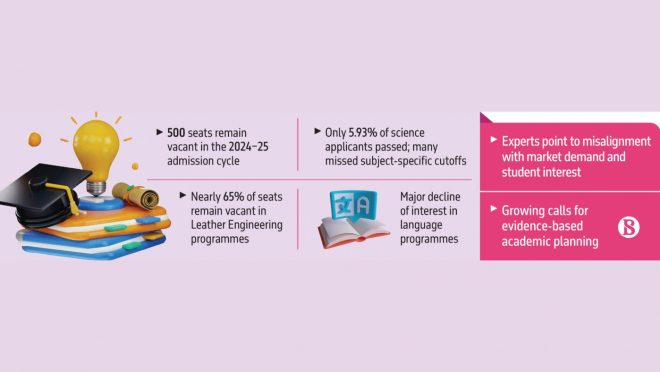Underfilled departments at DU reveal cracks in admission, academic planning
Underfilled departments at DU reveal cracks in admission, academic planning

Highlights
- 500 seats remain vacant in the 2024–25 admission cycle
- Only 5.93% of science applicants passed; many missed subject-specific cutoffs
- Nearly 65% of seats remain vacant in Leather Engineering programmes
- Major decline of interest in language programmes
- Experts point to misalignment with market demand and student interest
- Growing calls for evidence-based academic planning
Despite completing the undergraduate admission process for the 2024–25 academic year, several departments at Dhaka University (DU) have failed to fill all seats, revealing a mismatch between academic offerings and student demand.
Classes began in early July, yet many seats, especially in the arts and science faculties, remain vacant. Even after seven rounds of subject migration, departments such as Urdu, Persian, Sanskrit, and Pali continue to see low enrolment.
Technical fields like Leather Engineering and Technology also report nearly two-thirds of their seats unfilled. Other science departments face similar problems due to strict subject-specific admission criteria.
Professor Dr Mohammad Moninur Rashid of the Institute of Education and Research (IER) said, “Seat numbers at universities shouldn’t be fixed; they must be regularly reviewed.”
He stressed aligning seat allocation with market demand to prevent recurring under-enrolment.
Students are failing to meet the science programme’s requirements
Departments such as Physics, Applied Chemistry, and Electrical and Electronic Engineering struggled to fill seats because many applicants failed to meet minimum subject-specific marks. Out of 6,130 seats at DU this year, 505 remain vacant.
Only 5.93% of science unit candidates passed this year’s admission test – 7,437 out of 1,46,694. Applied Chemistry filled 32 of 60 seats, EEE 52 of 75, and Physics 64 of 100.
High GPAs alone don’t suffice; students must meet departmental criteria. “The government’s assumed high pass rates meant success, but we’re overmarking at school levels,” said Prof Rashid.
“That’s why 90% fail DU’s tests, and even those who pass often miss subject thresholds.” A faculty member echoed the concern, “The quality of education has declined, and students can’t secure qualifying marks.”
Language programme’s struggle amid diminishing interest
Language departments in the Faculty of Arts have faced low enrolment for three years despite repeated migration rounds. This year, Urdu has 35 vacant seats, Persian 21, Sanskrit 37, and Pali 22. Last year, these departments had 61 unfilled seats; in 2022–23, the number was 129.
Sumaiya Afrin (pseudonym) enrolled in Dhaka University’s Persian Language and Literature department in 2023-24 but later withdrew to sit for the admission test again. She is now studying English at Rajshahi University in the next session.
Speaking to The Business Standard, she said, “I didn’t mind Persian, I liked literature. But my family, especially close relatives, were unsure about the subject and its prospects. So, to honour their concerns, I took the test again and got into English at Rajshahi University.”
Experts say these departments are not adapting to students’ evolving interests or job market demands, causing steady declines despite their historical importance. Other language programmes like Chinese, Japanese, French, and Linguistics also report vacant seats.
Declining enrolment challenges leather engineering programmes
At the Institute of Leather Engineering and Technology, only 53 of 150 seats have been filled. Leather Engineering has 17 vacant seats out of 50; Footwear Engineering has filled only 29 seats, and 41 out of 50 seats remain empty in the Leather Products department.
“Compared to many departments, our job market and alumni performance are strong, but students don’t seem to perceive it,” said Professor Dr Mohammad Kamruzzaman, director of the institute. “Perhaps today’s generation is less inclined toward industrial careers. We faced similar issues last year; however, some seats were filled through new nominations.”
Vacancies persist even in practical and popular departments
Departments like Music and Dance, which require practical exams, also saw major shortfalls. This year, 36 out of 60 Music seats and 11 out of 30 Dance seats remain vacant. Last year, these two departments had 27 combined vacant seats.
Other departments across science and arts report scattered vacancies, though in smaller numbers. Subjects such as Geology, Education, Geography, Environmental Science, and newer ones like Television, Film, and Photography have unfilled seats despite high application volumes.
Policy gaps undermine seat management
Admission trends over the past two years confirm that certain departments consistently face under-enrolment despite migration efforts. Faculty involved in admissions say relaxing criteria or allowing more migration won’t solve the problem long-term.
Such measures may push students into lower-priority departments, worsening imbalances. DU currently does not allow subject reallocation after classes start, though this could be revised.
Since most universities have completed admissions, it’s unclear if enough eligible students remain to fill vacancies even if rules change.
“Despite all our efforts, some seats always remain vacant. In such cases, there’s very little we can do,” said DU Pro-Vice Chancellor (Academic) Professor Dr Mamun Ahmed.
Professor Dr Mostafizur Rahman, convener of DU’s online admission committee, said a meeting with the vice-chancellor is planned to decide next steps.
Experts argue DU must reassess institutional capacity. With 84 departments and 13 institutes, many lack alignment with job market needs. Infrastructure strains, from housing to transportation, also grow with rising enrolment.
“DU needs its own research to determine the workforce the country requires, our capacity, and how to provide quality education,” said Dr Moninur Rashid. He emphasised evidence-based planning to align programs with national goals while using resources efficiently.


